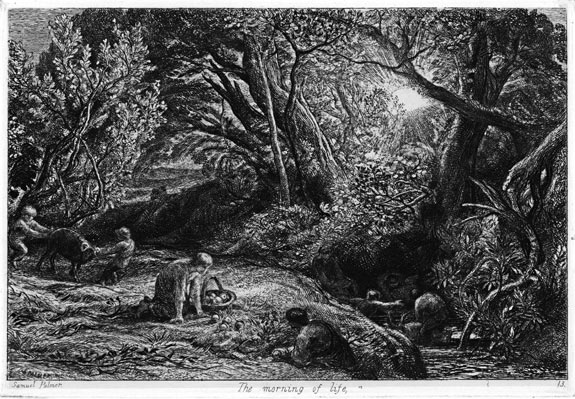|
Samuel
Palmer
(Newington,
south London 1805 – 1881 Redhill, near
Reigate, Surrey)
The
Morning of Life

The Morning of Life
Alexander 10 vi/vi, Lister 10 vii/vii
146 x 215 mm (plate)
136 x 229 mm (image)
265 x 366 mm (sheet)
Etching
and drypoint, 1860/61-1872. The plate signed. Final
state, as published as plate 13 in Etchings
for the Art Union of London by the Etching Club,
1872, with the associated lettering. Edition of 450,
printed by Frederick Goulding with retroussage;
the only issue. A rich impression on white laid
india paper. The edges of the wove support sheet
gilt.
Sold
|
|
Additional
Information about the Print
Palmer
began this plate as a subject taken from Virgil’s Aeneid, ‘Hercules & Cacus’.
When this proved unsatisfactory (I could no-how
clip my poodle into lion shape, as Palmer
expressed it in a letter to Hamerton in 1872 )
he altered the figures completely and transformed
it into the present Virgilian idyll, with sheep
washing and a conversation over apples. He also extended the etched area on all four sides, resulting in his only print with narrow plate borders. Palmer
wrote to his printer in 1871 instructing him to
erase the title Hercules and Cacus from
the plate, the” true title” being A
Leafy Dell. Palmer also referred to it as Sheep-washing and Work
and Gossip before finally settling on the
published version, The morning of life.
Not
only the theme but the practice gave Palmer great
difficulties. The copper plate was supplied by
the Etching Club and had already been used for
a previous etching and burnished clean for re-use
before Palmer himself was burnishing it again
to change his composition. A H Palmer in The
Life … (page
99) quotes his father on some of the problems as
he worked towards the finished image of the “wretched
plate [which had] bent up like an earwig disturbed
in an egg-plum."
I
spent several days working and proving in London
in a ghastly frame of mind, owing, for once, not
to my own clumsiness, but to the detestability,
both as to thinness and quality, of the old, scraped,
Club copper on which [my
etching] was done. I gave myself up for lost on
Saturday at 5.30, but, by a desperate perseverance,
had singed the last neck of the hydra by 6.15,
and hope to send you soon, one of the very best
impressions.
The
published edition was the first printed by Goulding,
advocate of retroussage, for the Etching Club
and Palmer was taken aback by the dramatic printing,
very different in effect to the clean-wiped plates
of the previous Club printers Gad & Keningale.
None the less the following year, 1873, when he
acquired his private press, Palmer would engage
Goulding to teach his son Herbert to
print. Goulding demonstrated retroussage and
A H Palmer used the method, which he calls ‘artistic
printing’ for
subsequent Palmer proofs.
|